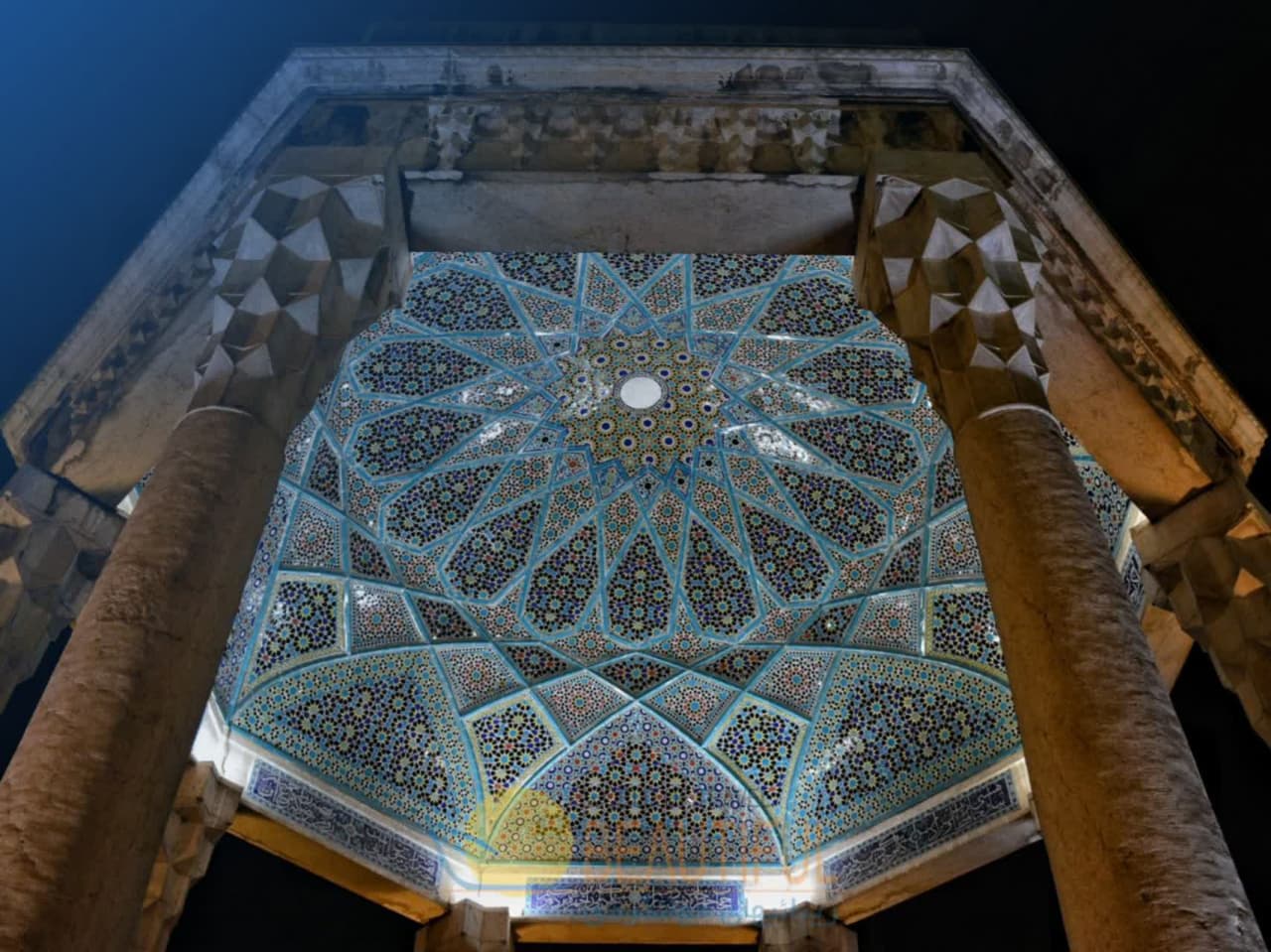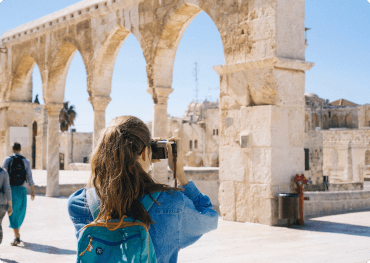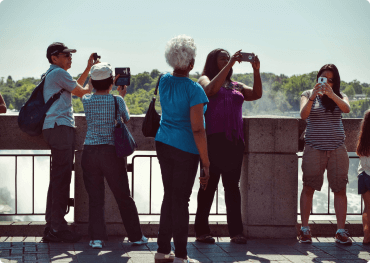
CU-124
Package Details
Day 1: Flight from your home country to Tehran capital of IRAN
Day 2: Tehran
Arrival Tehran meets and assists at airport and then transfer to Hotel. After noon, visit Niyavaran Palace
And Bazaar Tajrish and Enanzadeh Saleh mausoleum.
The Niavaran Complex is a historical complex situated in Shemiran, Tehran (Greater Tehran), Iran. It consists of several buildings and monuments built in the Qajar and Pahlavi eras. The complex traces its origin to a garden in Niavaran region, which was used as a summer residence by Fath-Ali Shah of the Qajar Dynasty. A pavilion was built in the garden by the order of Naser ed Din Shah of the same dynasty, which was originally referred to as Niavaran House, and was later renamed Saheb Qaranie House. The pavilion of Ahmad Shah Qajarwas built in the late Qajar period.During the reign of the Pahlavi Dynasty, a modern built mansion named Niavaran House was built for the imperial family of Mohammad Reza Pahlavi. All of the peripheral buildings of the Saheb Qaranie House, with the exception of the Ahmad Shahi Pavilion, were demolished, and the buildings and structures of the present-day complex were built to the north of the Saheb Qaranie House. In the Pahlavi period, the Ahmad Shahi Pavilion served as an exhibition area for the presents from world leaders to the Iranian monarchs.
leaders to the Iranian monarchs.
O/N: Tehran.
Imāmzādeh Sāleh is one of many Imāmzadeh mosques in Iran. The mosque is located at Tajrish Square in Tehran's northern Shemiran district. The mosque entombs the remains of Sāleh, a son of the Twelver Shī‘ah Imām, Mūsā al-Kādhim, and is one of the most popular Shī‘ah shrines in northern Tehran.
Day3: Tehran - Shiraz
After breakfast, visit Tehran Golestan Palace, Moghadam museum. After noon transfer to train station travel to Shiraz. (departure at 16:20PM ) .We use night train to save one day for sightseeing, if we use to travel by air, we should go to the airport 4 hours before departure and have security check, it train we join with normal peoples and learn about habitant, customs and protocol During rail trip, clients can drop in every station and know different peoples and culture.
The Golestan Palace : literally the Roseland Palace, is the former royal Qajar complex in Iran's capital city, Tehran.The oldest of the historic monuments in Tehran, and of world heritage status, the Golestan Palace belongs to a group of royal buildings that were once enclosed within the mud-thatched walls of Tehran’s Historic Arg (citadel). It is a masterpiece of beautiful garden and buildings consist of collection of Iranian crafts and European presents from 18th and 19th century. Golestan Palace Complex consists of 17 structures including palaces, museums, and halls. Almost all of this complex was built during the 200 years ruling of Qajarian kings. These palaces were used for many different occasions such as coronation and other important celebrations. It also consists of three main archives as the royal photographic archive collection 'Album khane', the royal library of manuscripts 'Ketabkhane Nosakhe khati' and the archive of documents 'Markaze asnad'.
O/N: In Train.
Day4: Shiraz
We arrive to Shiraz at 07:00AM, transfer from rail station to the hotel and check in. Full day city tour to visit Vakil complex (bath, museum & bazaar) as well as Karimkhani CitadelAnd Eram garden, Aramgah e Saadi and Hafez (tombs of the Iranian Poets).
The Vakil Mosque is a mosque in Shiraz, southern Iran, situated to the west of the Vakil Bazaar next to its entrance. This mosque was built between 1751 and 1773, during the Zand period; however, it was restored in the 19th century during the Qajar period. Vakil means regent, which was the title used by Karim Khan, the founder of Zand Dynasty. Shiraz was the seat of Karim Khan’s government and he endowed many buildings, including this mosque.
Vakil Bath is an old public bath in Shiraz, Iran. It was a part of the royal district constructed during Karim Khan Zand's reign, which includes Arg of Karim Khan, Vakil Bazaar, Vakil Mosque and many administrative buildings. The monument is inscribed with the number 917 on the list of national works of Iran.
Vakil Bazaar is the main bazaar of Shiraz, Iran, located in the historical center of the city. It is thought that the market originally was established by the Buwayhids in the 11th century AD, and was completed mainly by the Atabaks of Fars, and was renamed after Karim Khan Zand only in the 18th century. The bazaar has beautiful courtyards, caravansarais, bath houses, and old shops which are deemed among the best places in Shiraz to buy all kinds of Persian rugs, spices, copper handicrafts and antiques. Like other Middle Eastern bazaars, there are a few mosques and Imamzadehs constructed beside or behind the bazaar.
The Tomb of Hafez and its associated memorial hall, the Hāfezieh, are two memorial structures erected in the northern edge of Shiraz, Iran, in memory of the celebrated Persian poet Hafez. The open pavilion structures are situated in the Musalla Gardens on the north bank of a seasonal river and house the marble tomb of Hafez. The present buildings, built in 1935 and designed by the French architect and archaeologist André Godard, are at the site of previous structures, the best-known of which was built in 1773. The tomb, its gardens, and the surrounding memorials to other great figures are a focus of tourism in Shiraz.
The Tomb of Saadi is a tomb and mausoleum dedicated to the Persian poet Saadi in the Iranian city of Shiraz. Saadi was buried at the end of his life at a Khanqah at the current location. In the 13th century a tomb built for Saadi by Shams al-Din Juvayni, the vizir of Abaqa Khan. In the 17th century, this tomb was destroyed. During the reign of Karim Khan was built a mausoleum of two floors of brick and plaster, flanked by two rooms.
The current building was built between 1950 and 1952 to a design by the architect Mohsen Foroughi and is inspired by the Chehel Sotoun with a fusion of old and new architectural elements. Around the tomb on the walls are seven verses of Saadi’s poems.
O/N: Shiraz.
Day5: Shiraz – Isfahan
Early morning drive to Isfahan (483KM), in the way visit Persepolis, Naghsh-e Rostam.
O/N: Isfahan.
Persepolis the name of one of the ancient cities of Iran that joined over the years, the capital 's stately and ceremonial monarchy at the time of the Achaemenid Empire was. In this ancient city called Persepolis palace that during the reign of Darius , Xerxes and Artaxerxes was built and was built for about 200 years. On the first day of the New Year , many groups from different countries representing Satrapyha or governments gathered in Persepolis with diverse took offerings and gifts were presented to the king.
Persepolis in 518 BCE as the new capital of the Achaemenid the gamers began. Founder of Persepolis, Darius was, of course, after his son Xerxes and his grandson Artaxerxes I to extend this series to expand it added. Many existing knowledge about the history and culture of the Achaemenid stone inscriptions and Flznvshthhayy is available for the palaces and on the walls and the tablet is engraved. Sumner has estimated that the plain of Persepolis which contains 39 residential camp was in the Achaemenid period 43, 600 people had.
Historians believe that Alexander the Macedonian commander Greek in 330 BC, invaded Iran and burned Persepolis and probably a large part of the books, Achaemenid art and culture destroyed by it. However, the ruins of this place is still up and archeology of its ruins signs of fire and rush to acknowledge it.
This place since 1979, one of Iran's record on the UNESCO World Heritage is.
Persepolis in the northern city near Shiraz , south of Fars province (northeast of Shiraz ) is replaced.
At a distance of six and a half kilometers from Persepolis, Naqsh-e Rustam is located.
Naqsh-e Rustam name of the ancient collection Zangiabad village located in the northern city of Shiraz in Fars province of Iran , which is 6 kilometers from Persepolis is located. Yadmanhayy the archaeological site of the Elamite , Achaemenid and Sassanid in its place and has around 1200 BC to 625 AD was the focus of attention because the tomb four kings Achaemenid, Sassanian reliefs of a number of major events, building the Kaaba of Zoroaster and Vyranshdhay relief from the Elamite era in this place and in the Sassanid era, Naqsh-e Rustam area of religious and national importance have been.
In the past, this place was Dogonbadan Segonbad or among the people of the region were caught by the names of the mountain, the mountain was also called Nfsht pool or mountains after the Iranians and possibly the name of Naqsh-e Rustam between Rostam , the hero of Shahnameh and communicate the Sassanid kings were Sngngarhhay It was to this place.
The oldest role in Naqsh-e Rustam is the Elamite period and the king and queen of the gods and goddesses were portrayed, but later in the Sassanid era, Bahram II parts of it wiped and his role and his courtiers erected in its place. Kaaba of Zoroaster and Brjmannd in the Mhvthast stone building that was built during the Achaemenid period is likely to be unclear and its application is based on three corners of the building has two inscriptions of Shapur I and Kartir written that historically are of great value.
Four Tomb dungeon in the bosom of the Mountain of Mercy have been dug that belonged to Darius the Great , Xerxes , Artaxerxes I , and Darius II that all of them have the same properties.
Ardashir the first one who in this area, Sngngarhay shaved and Tajgyryash scene of Ahura Mazda recorded. He also Tajgzaryshan Sassanid kings scenes or descriptions of battles and Aftkhartshan on the breast of the mountain. That Artaxerxes and his son Shapur II Nqshbrjsthhayy counterparts in the Achaemenid reliefs in Naqsh-e Rustam shaved, probably in imitation of the past have been the political and cultural sequences.
Day6: Isfahan
Full day visiting Isfahan: Naghsh e Jahan Square, Emam Mosque, Alighapoo Palace, Sheykh Lotf-ol lah Mosque, old Bazaar, Chehel soton.
Naqsh-e Jahan Square, known as Imam Square, formerly known as Shah Square, is a square situated at the center of Isfahan city, Iran. Constructed between 1598 and 1629, it is now an important historical site, and one of UNESCO's World Heritage Sites. It is 160 metres (520 ft) wide by 560 metres (1,840 ft) long (an area of 89,600 square metres (964,000 sq ft)). The square is surrounded by buildings from the Safavid era. The Shah Mosque is situated on the south side of this square. On the west side is the Ali Qapu Palace. Sheikh Lotf Allah Mosque is situated on the eastern side of this square and at the northern side Keisaria gate opens into the Isfahan Grand Bazaar. Today, Namaaz-e Jom'eh (the Muslim Friday prayer) is held in the Shah Mosque.
The square is depicted on the reverse of the Iranian 20,000 rials banknote.
The Lotfollah Mosque : The Lotfollah Mosque had a secret entrance that spanned underneath the Maidan, from the Palace on the opposite side of the square.
Of the four monuments that dominated the perimeter of the Naqsh-e Jahan square, the Lotfollah Mosque, opposite the palace, was the first to be built. The purpose of this mosque was for it to be a private mosque of the royal court, unlike the Shah mosque|Masjed-e Shah, which was meant for the public.[16] For this reason, the mosque does not have any minarets and is of a smaller size. Indeed, few Westerners at the time of the Safavids even paid any attention to this mosque, and they certainly did not have access to it. It wasn't until centuries later, when the doors were opened to the public, that ordinary people could admire the effort that Shah Abbas had put into making this a sacred place for the ladies of his harem, and the exquisite tile-work, which is far superior to those covering the Shah Mosque.
Ali Qapu is in effect but a pavilion that marks the entrance to the vast royal residential quarter of the Safavid Isfahan which stretched from the Maidan Naqsh-i-Jahan to the Chahar Bagh Boulevard. The name is made of two elements: "Ali", Arabic for exalted, and "Qapu" Turkic for portal or royal threshold. The compound stands for "Exalted Porte". This name was chosen by the Safavids to rival the Ottomans' celebrated name for their court : Bab-i Ali, or the "Sublime Porte"). It was here that the great monarch used to entertain noble visitors, and foreign ambassadors.
Shah Abbas, here for the first time celebrated the Nowruz (New Year's Day) of 1006 AH / 1597 A.D. A large and massive rectangular structure, the Ali Qapu is 48 m (157 ft) high and has six floors, fronted with a wide terrace whose ceiling is inlaid and supported by wooden columns.
On the sixth floor, the royal reception and banquets were held. The largest rooms are found on this floor. The stucco decoration of the banquet hall abounds in motif of various vessels and cups. The sixth floor was popularly called (the music room) as it was here that various ensembles performed music and sang songs. From the upper galleries, the Safavid ruler watched polo games, maneuvers and horse-racing below in the Naqsh-i-Jahan square.
The Bazaar of Isfahan is a historical market and one of the oldest and largest bazaars of the Middle East. Although the present structure dates back to the Safavid era, parts of it are more than a thousand years old, dating back to the Seljuq dynasty. It is a vaulted, two kilometer street linking the old city with the new.
Chehel Sotoun ( “Forty Columns”) is a pavilion in the middle of a park at the far end of a long pool, in Isfahan, Iran, built by Shah Abbas II to be used for his entertainment and receptions. In this palace, Shah Abbas II and his successors would receive dignitaries and ambassadors, either on the terrace or in one of the stately reception halls.The name, meaning "Forty Columns" in Persian, was inspired by the twenty slender wooden columns supporting the entrance pavilion, which, when reflected in the waters of the fountain, are said to appear to be forty.As with Ali Qapu, the palace contains many frescoes and paintings on ceramic. Many of the ceramic panels have been dispersed and are now in the possession of major museums in the west. They depict specific historical scenes such as the infamous Battle of Chaldiran against the Ottoman Sultan Selim I, the reception of an Uzbek King in 1646, when the palace had just been completed; the welcome extended to the Mughal Emperor, Humayun who took refuge in Iran in 1544; the battle of Taher-Abad in 1510 where the Safavid Shah Ismail I vanquished and killed the Uzbek King. A more recent painting depicts Nader Shah's victory against the Indian Army at Karnal in 1739. There are also less historical, but even more aesthetic compositions in the traditional miniature style which celebrate the joy of life and love.
The Chehel Sotoun Palace is among the 9 Iranian Gardens which are collectively registered as one of the Iran’s 17 registered World Heritage Sites under the name of the Persian Garden.
At night, visit Old Bridge Se o Se Pol (Big Bridge with 33 arches) and Khajo Bridge.
Khaju Bridge is a bridge in the province of Isfahan, Iran, which has been described as the finest in the province. It was built by the Persian Safavid king, Shah Abbas II around 1650, on the foundations of an older bridge. Serving as both a bridge, and a dam (or a weir), it links the Khaju quarter on the north bank with the Zoroastrian quarter across the Zayandeh River. Although architecturally functioning as a bridge and a weir, it also served a primary function as a buildingand a place for public meetings. This structure was originally decorated with artistic tilework and paintings, and served as a teahouse.
Allāhverdi Khan Bridge, popularly known as Si-o-seh pol “The bridge of thirty-three spans” is one of the eleven bridges of Isfahan, Iran and the longest bridge on Zayandeh River with the total length of 297.76 metres (976.9 ft). It is highly ranked as being one of the most famous examples of Safavid bridge design.
It was constructed by the finance and the inspection of Allahverdi Khan Undiladze chancellor of Shah Abbas I, an ethnic Georgian, it consists of two rows of 33 arches from either sides, left and right.
There is a larger base plank at the start of the bridge where the Zayandeh River flows under it, supporting a tea house which nowadays is abandoned due to the shortage of water and the river drought.
O/N: Isfahan
Day 7: Isfahan
Full day tour of Isfahan.
Hasht Behesht, meaning "Eight Paradises" is a Safavid era palace in Isfahan.
It was built in 1669 and is today protected by Iran's Cultural Heritage Organization. Of more than forty mansions which existed in Isfahan during the rule of Safavids, this is the only one left today.
Holy Savior Cathedral is a cathedral located in the New Julfa district of Isfahan, Iran. It is commonly referred to as the Vank (Վանք), which means "monastery" or "convent" in Armenian language.
The cathedral was established in 1606, dedicated to the hundreds of thousands of Armenian deportees that were resettled by Shah Abbas I during the Ottoman War of 1603-1618.
The varying fortunes and independence of this suburb across the Zayande River and its eclectic mix of European missionaries, mercenaries and travelers can be traced almost chronologically in the cathedral's combination of building styles and contrasts in its external and internal architectural treatment.
The Jāmeh Mosque of Isfahān is the grand, congregational mosque (Jāmeh) of Isfahān city, within Isfahān Province, Iran. The mosque is the result of continual construction, reconstruction, additions and renovations on the site from around 771 to the end of the 20th century. The Grand Bazaar of Isfahan can be found towards the southwest wing of the mosque. It is a UNESCO World Heritage Site since 2012.
This is one of the oldest mosques still standing in Iran, and it was built in the four-iwan architectural style, placing four gates face to face. An iwan is a vaulted open room. The qibla iwan on the southern side of the mosque was vaulted with muqarnas during the 13th century. Muqarnas are niche-like cells.
O/N: Isfahan.
Day: 8 Isfahan - Kashan
After breakfast drive from Isfahan to Kashan (218 KM). Visit Brojerdi and Tabatabai old houses, Fien Garden.
Fin Garden, or Bagh-e Fin, located in Kashan, Iran, is a historical Persian garden. It contains Kashan's Fin Bath, where Amir Kabir, the Qajarid chancellor, was murdered by an assassin sent by King Nasereddin Shah in 1852. Completed in 1590, the Fin Garden is the oldest extant garden in Iran.
The origins of the garden may be anterior to the Safavid period; some sources indicate that the garden has been relocated from another place, but no clear picture of it has been found.
The settlements of the garden in its present form was built under the reign of Abbas I of Persia (1571-1629), as a traditional bagh near the village of Fin, located a few kilometres southwest of Kashan.
The garden was developed further during the Safavid dynasty, until Abbas II of Persia (1633-1666). It was highly recognized during the reign of Fat′h Ali Shah Qajar and was considerably expanded.
The garden subsequently suffered from neglect and was damaged several times until, in 1935, it was listed as a national property of Iran. On 2007, 8 September, Bagh-e Fin was submitted to the Unesco's Tentative List.
Home Borujerdian the historic city of Kashan is. The building is located in the neighborhood Sultan Mir Ahmad and in the second half of the 13th century Hijri built in Qajar era and was registered under the number 1083 in the national index. The house has a beautiful crescent-shaped symmetrical vents on the roof of the hall and pergola on one of the most beautiful manifestations of Persian architecture to display it. So that the inscriptions on all four sides of the hall, the building dates back to 1292 BC E…
Paintings, valuable and Gchbryhay this house, under the Sani-ol-Molk, the great Iranian painter and uncle Kamalolmolk been implemented. The owner of the house, Haj Seyed Mehdi Natanz Natanz businessmen residing in Kashan and architect of the master Ustad Ali Maryam was. Because of his many trips to the city of Boroujerd have known Boroujerdi. He loved the girl’s Tabatabai Tabatabai also one of the largest carpet merchant, and then leaves to consent to the marriage condition. His beautiful home which is now called the house Tabatabaian known as lived and Mehdi says he must build a house like my house to get my daughter to Hmsryt in. Mehdi also accepts and ends after 7 years to build the inner courtyard and living at home after 11 years in the main hall is completed. Boroujerdi House in Kashan Cultural Heritage Administration is now home.
Brvjrdyhay historic house in Kashan in terms of popularity tourist attraction as a top choice UNESCO in 2015 and 2016 respectively.
Home Tabatabaian which was registered under number 1504, in the second half of the 13th century AH by Haj Seyed Jafar Tabatabai merchants Natanz resident of Kashan in the neighborhood Sultan Amir Ahmad was built.
Architect manufacturer of the master Ustad Ali Maryam and plaster involved in the art and drawings by students Mirza Abul Hassan Sani-ol-Molk Ghaffari Kashani, and under him were doing.
On the way to the International air port, dinner en route
After dinner, we continue to go to the airport for formality to check in with airline to travel back home
As all international airlines fly from Tehran early morning to arrive passengers to European destination, therefore we can’t enter Tehran and check in with the hotel, because we have no more time to rest and should return to airport immediately.
Day9: Departur
Early morning fly back to home and ending memorable trip to Great Iran
Details
Pellentesque accumsan magna in augue sagittis, non fringilla eros molestie. Sed feugiat mi nec ex vehicula, nec vestibulum orci semper. Class aptent taciti sociosqu ad litora torquent per conubia nostra, per inceptos himenaeos. Donec tristique commodo fringilla. Duis aliquet varius mauris eget rutrum. Nullam sit amet justo consequat, bibendum orci in, convallis enim. Proin convallis neque viverra finibus cursus. Mauris lacinia lacinia erat in finibus.
Pellentesque accumsan magna in augue sagittis, non fringilla eros molestie. Sed feugiat mi nec ex vehicula, nec vestibulum orci semper. Class aptent taciti sociosqu ad litora torquent per conubia nostra, per inceptos himenaeos. Donec tristique commodo fringilla.
- Specilaized Bilingual Guide
- Private Transport
- Entrance Fees
- Box Lunch,Water,Dinner and Snacks
Pellentesque accumsan magna in augue sagittis, non fringilla eros molestie. Sed feugiat mi nec ex vehicula, nec vestibulum orci semper. Class aptent taciti sociosqu ad litora torquent per conubia nostra, per inceptos himenaeos. Donec tristique commodo fringilla.
- Specilaized Bilingual Guide
- Private Transport
- Entrance Fees
- Box Lunch,Water,Dinner and Snacks
Pellentesque accumsan magna in augue sagittis, non fringilla eros molestie. Sed feugiat mi nec ex vehicula, nec vestibulum orci semper. Class aptent taciti sociosqu ad litora torquent per conubia nostra, per inceptos himenaeos. Donec tristique commodo fringilla.
- Specilaized Bilingual Guide
- Private Transport
- Entrance Fees
- Box Lunch,Water,Dinner and Snacks
Pellentesque accumsan magna in augue sagittis, non fringilla eros molestie. Sed feugiat mi nec ex vehicula, nec vestibulum orci semper. Class aptent taciti sociosqu ad litora torquent per conubia nostra, per inceptos himenaeos. Donec tristique commodo fringilla.
- Specilaized Bilingual Guide
- Private Transport
- Entrance Fees
- Box Lunch,Water,Dinner and Snacks
Pellentesque accumsan magna in augue sagittis, non fringilla eros molestie. Sed feugiat mi nec ex vehicula, nec vestibulum orci semper. Class aptent taciti sociosqu ad litora torquent per conubia nostra, per inceptos himenaeos. Donec tristique commodo fringilla.
- Specilaized Bilingual Guide
- Private Transport
- Entrance Fees
- Box Lunch,Water,Dinner and Snacks






















